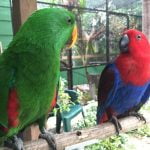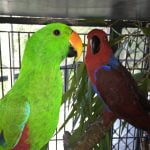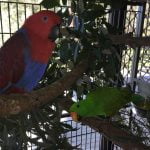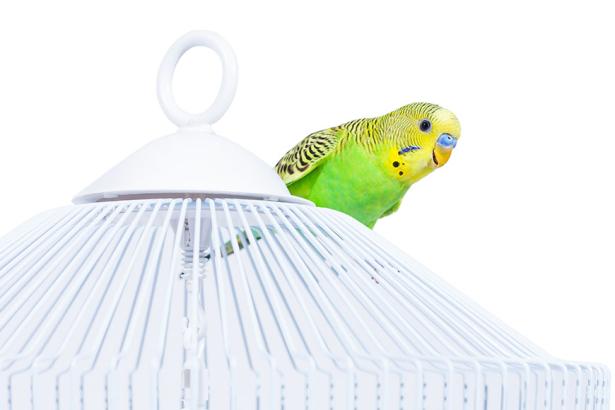Why introduce a new bird?
Birds are flock animals and their behaviour is geared to interaction within a flock. Captive, pet birds, living in our households, adopt the human family as their flock. This can cause many behavioural problems with the pet parrot as humans don’t understand the need to socialize and train the young bird. As a result, many birds develop stress and anxiety related disorders because they are never taught what the “flock” expects of them. They become like spoilt, out-of-control children who have never been set boundaries or taught manners or social skills.
Owners of pet birds need to learn how to become the “older bird” in the flock. They need to learn how to train the bird to follow some simple commands and to learn its place in the “pecking order”. If bird owners fail to train their bird, the bird will certainly train them. Training of birds or training owners to interact appropriately with their pet is too complex an issue to be dealt with in this article. Therefore, I will concentrate on the problems that result from untrained, pet birds that bond inappropriately with their human owners.
Untrained pet birds that “rule the roost”, use their voice, beak and wings to command their owner to fulfil their needs. Well-meaning, but unsuspecting owners, allow this to happen. The bird spends its time on the owner’s shoulder and feels that it is equal in status to the humans in the flock. These problems are compounded when the bird reaches puberty. I am constantly telling owners that “your bird will have a sex life whether you want it to or not.” Unlike pet cats and dogs that are desexed or neutered when they reach puberty, we don’t routinely desex birds. When pet birds’ hormones kick in at puberty, their instincts tell them to choose a mate. Owners who constantly allow their bird on their shoulders, and who kiss them and allow them to eat food out of their mouth, are inadvertently engaging in “birdy foreplay”. This behaviour sends the wrong signals to a pubescent bird. They will inappropriately bond with this human, choosing him or her as their mate. This can result in many different behavioural disorders.
- The birds will try and mate with their “human” partner (males will often masturbate and females will “present” to their chosen mate)
- They will “mate guard” (become very protective to their chosen human mate and aggressive to any other family members)
- Female birds will often become chronic egg layers
- Males often feather pluck in frustration
- Some birds without a suitable mate will develop obsessive compulsive disorders or displacement activity (they will often drink excessively and consequently have very watery droppings)
- Many will call obsessively when their “chosen human mate” it out of sight (i.e. at work or school)
All of these disorders can be resolved by training your bird and also by allowing a bird to follow its instincts and bond with another feathered friend.
When to choose a mate?
The sooner the better, before the single, untrained pet bird becomes inappropriately bonded to a member of the human flock.
What type of mate?
It is always best to choose a mate of the opposite sex of the same species. Some well-meaning but misguided people think that getting a different type of bird will provide a playmate for their pet parrot. We have some clients who have purchased a budgie as a mate for their cockatiel. It worked very well!!! The budgie and the cockatiel bonded but they still can’t mate and now they are both frustrated. This would be like trying to pair up a cow and a horse. It just doesn’t compute. If you are going to choose a mate of the opposite sex for your bird it is necessary to know the sex of your current bird. Sex of the bird can be determined by DNA sexing with a blood feather or a blood sample or by surgically sexing with a laparoscopic examination to determine whether the bird has testes or ovaries.
How to introduce a mate?
Always get a new bird health checked by an experienced avian veterinarian, to ensure that you are not introducing disease problems to your existing bird. Don’t put the new bird into the existing bird’s cage straight away. Do what we call, a “soft introduction”. You will need two cages. The new bird’s cage is placed next to the existing bird’s cage. Birds are territorial and will resist an interloper who invades their territory. Just like us, they need to get to know a stranger before they invite them into their homes. While the existing bird is caged, the new bird can be allowed to have some “hassle free” time in the household environment (under strict supervision). Sometimes you can swap cages. Allow the new bird some time in the old bird’s cage and vice versa. The two birds can have time on the parrot perch together (under strict supervision). Only put them together in the one cage when they have had plenty of time to become used to each other; and only put them together when you have time to observe them closely. The time of the “soft introduction” depends on the birds and circumstances. Some birds bond within a few hours, others take days or weeks. As an example, I acquired an adult, malimprinted (humanized), male Hans Macaw and decided to introduce him to a young, hand-raised female. This took about six months of gradual introduction and supervised interaction. However, they are now happily ensconced in a brand new cage, enjoying each other’s company.
Once the two birds are together in one cage, have two feed and water stations so that there will be no rivalry over food. Make sure that perches are level; don’t have sloping perches as this can cause “dominance” problems.
Debunking myths about owning two birds
Do I have to be overrun with baby birds? No, you can practice a form of “birth control”. If and when eggs are laid, boil and mark with a pencil and replace in the nest box. Leave the eggs in the box for the incubation period (approx. 3 weeks). This is not bird murder as the eggs are only potential chicks when they have just been laid.
Will my bird become less friendly if it has a mate? No, if you follow accepted training and behaviour principles with each bird, you will end up having two tame pet birds. However, you must remember to train each bird separately as they can distract each other if you attempt to train them at the same time. Of course, during mating and egg laying, the birds will become protective of each other and territorial of their cage. However, this is a seasonal occurrence and often happens whether the birds have mates or not.
By training and socialising your pet bird and introducing a mate of the opposite sex and the same species, before your bird is inappropriately bonded to you or another family member, you will go a long way to avoiding behavioural problems associated with sexual frustration.
Information supplied by (c) Currumbin Valley Vet Services August 2010
FAQs
You should begin by placing them next to each other in separate cages and allow enough time for them to become accustomed to one another. If you put them together in the same cage too soon, they may fight and injure one another, resulting in you having to do an online search for an emergency bird vet near me. Once the birds are suitably accustomed, you can then place them in the same cage, but be sure to provide two food and water bowls so they don’t fight over them.
As the owner, you need to be the older bird of the flock by training your bird appropriately. You should not allow the bird on your shoulder as this makes the bird feel it is of equal status to you. Don’t kiss your bird or allow them to eat out of your mouth as this sends the wrong signals to your bird and they will inappropriately bond with you. If you need help training your bird or addressing any behavioural issues, contact your local avian doctor or bird animal hospital for assistance.









Lovely couple!